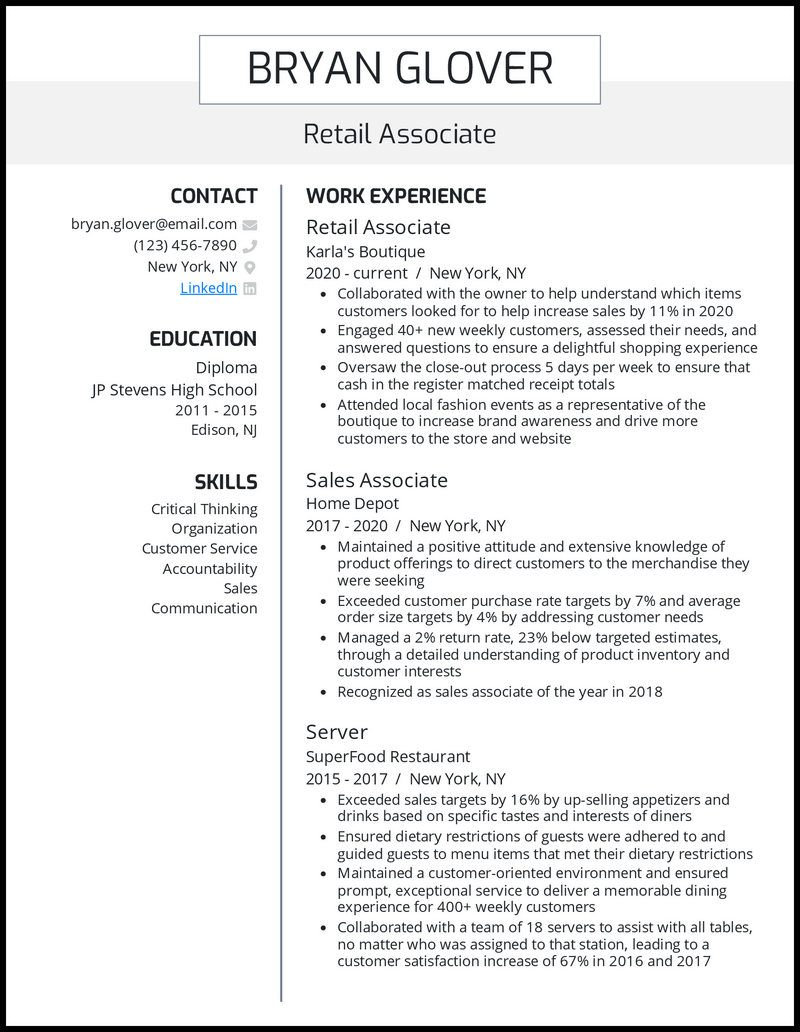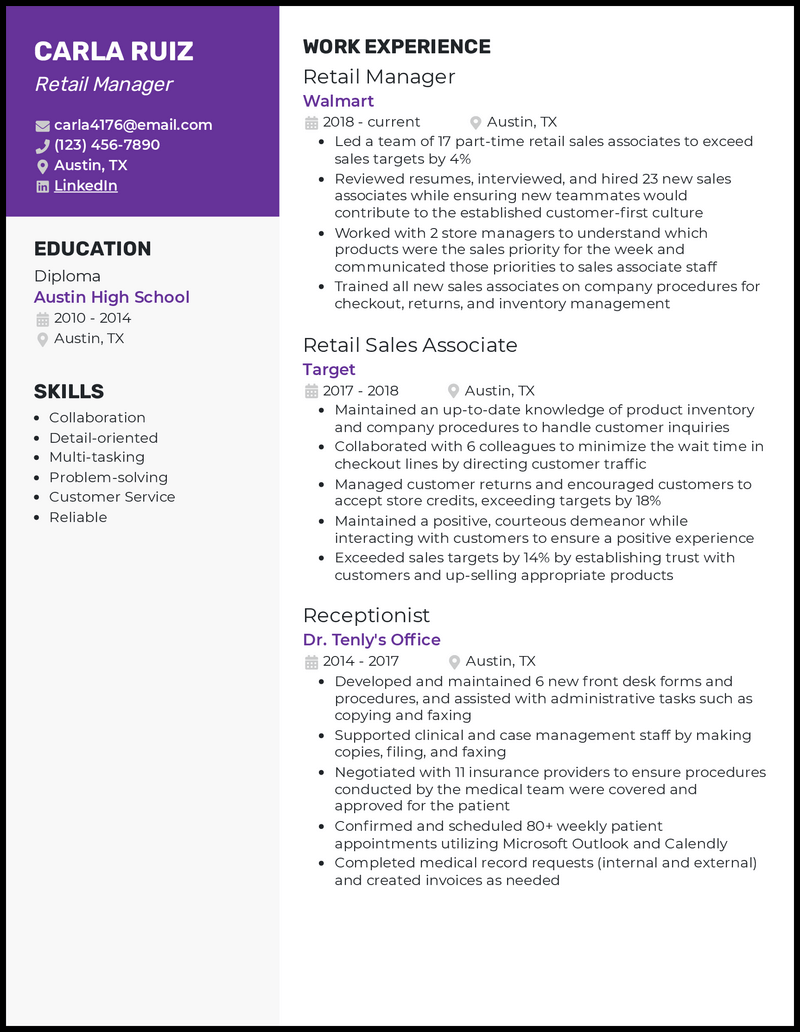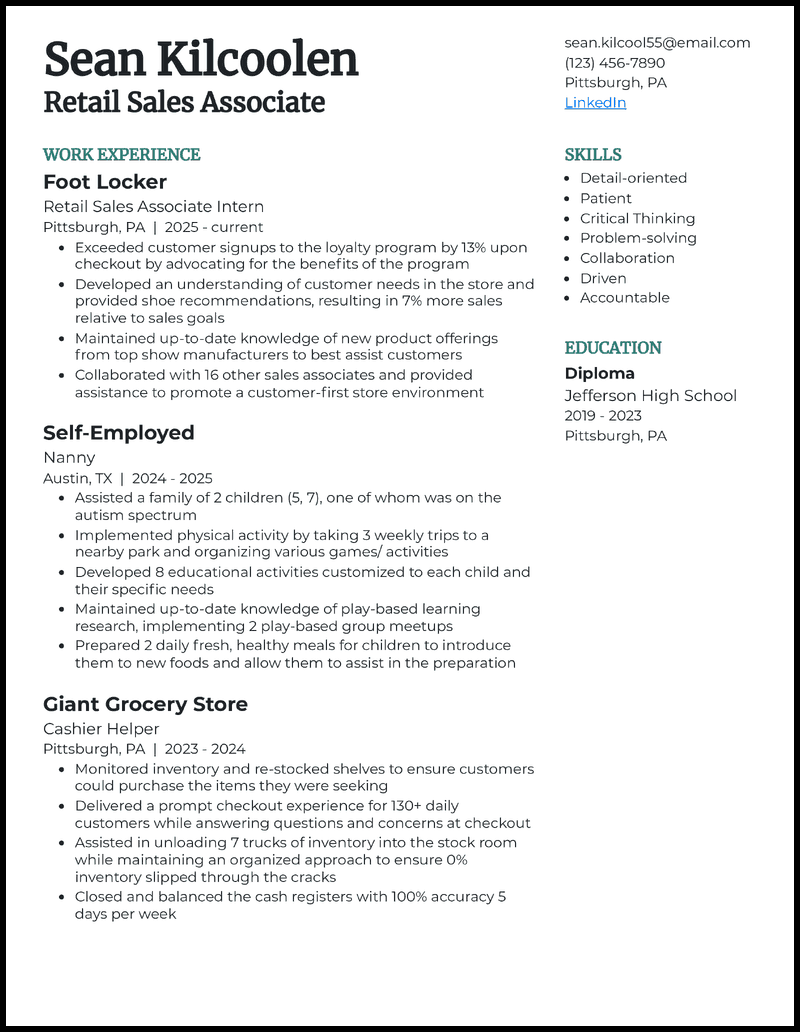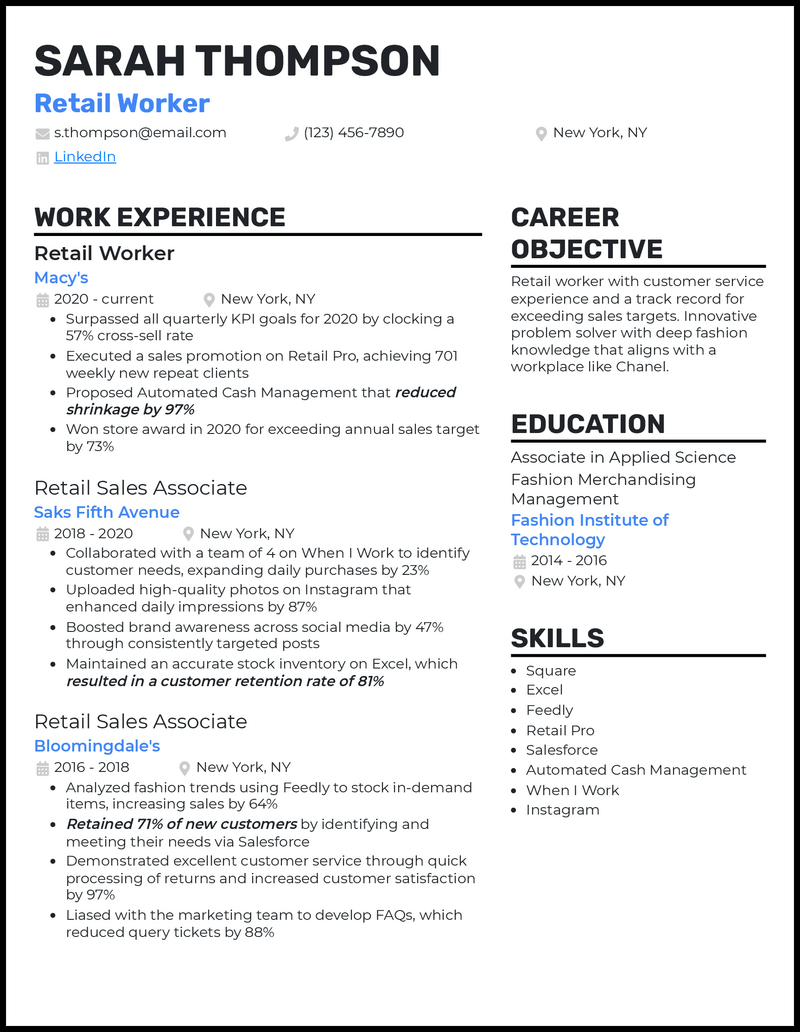From standing behind the counter, juggling customers, stock, and sales targets, your retail resume needs all the daily little wins to impress employers. Showing these retail skills and achievements can be difficult when creating your resume or cover letter.
That’s exactly why we’ve created this guide. Stick around and you’ll find:
- ↪ 13 great retail resume examples
- ↪ The best job-winning formatting tips
- ↪ Some commonly asked questions about retail resumes
Why this resume works
- Retail workers have to blend both sales and customer service. On the customer service side, your resume should demonstrate that you’ve taken a customer-first approach in your roles.
Why this resume works
- Your retail manager resume should clearly state the number of employees you’ve managed in any past management roles. You should also be clear about any hiring or training you’ve led. Including these metrics shows the hiring manager that you know what matters most to a retail manager.
View more retail manager resumes >
Why this resume works
- Most retail sales associates, especially for large retail chains, are given sales targets each month that they need to hit. If you have experience in retail sales, then you should mention how you performed against these sales targets on your retail sales associate resume.
View more retail associate resumes >
Why this resume works
- This is a customer service job, and your people skills should come at the top. Answering queries, solving problems, number of customer attended to, and the business value of such intercations are metrics you must pay attention to.
Why this resume works
- Highlight how you’ve maintained a high customer satisfaction rating even in a non-sales role to prove credibility in keeping end-users happy— a valuable aspect of any sales position.
Why this resume works
- Strongly show your customer service and communication skills and capabilities to solve problems instantly in your retail worker resume.
View more retail worker resumes >
Why this resume works
- Highlight your proficiency in sales management, growth, and ability to boost customer retention and satisfaction.
View more luxury retail resumes >
Why this resume works
- Prove how you’re versatile with different scenarios and boost a brand’s reputation in multiple ways. You can dive into the how and why of these details in your retail cover letter.
Why this resume works
- Elevate your retail buyer resume by using the right template with ample space to detail various work duties like scheduling purchases, finding cost-savings in supply chains, and reordering products on time.
Why this resume works
- Display proactiveness in your resume by having a healthy blend of past retail-related work experiences along with skills such as Square POS, Retail Pro, and When I Work.
Why this resume works
- A retail keyholder resume that makes the most out of numbers can showcase your potential value to the hiring company and see you stand leagues above your opponents. Example: “Coordinated eCommerce integrations via Shopify, adding 78 SKUs online and driving a $9,664 boost in monthly sales”.
Why this resume works
- Volunteer experience is worth including on your entry-level retailresume. It showcases that you’re hard-working and fundamentally interested in helping others. These are both qualities retail hiring managers are seeking.
View more entry-level retail resumes >
Why this resume works
- Before you click on the “Submit” button, please take a moment to proofread your high-end luxury retail resume. Skipping this step is a cardinal sin that might have the hiring manager moving on without a second glance.
Related resume guides
How to Format Your Retail Resume

Writing the perfect retail resume is the exact skill you need to earn a job as a sales representative, customer service representative, sales associate, or cashier. While the content of your resume is of the utmost importance, it’s also essential that you properly format your resume to ensure that it’s readable, logical, and complete. To that end, there are three formatting components you should be aware of, which include
- Reverse-Chronological Format, Functional Format, and Combination/Hybrid Format
- Contact Info and Header
- ATS and Readability

Retail resume format types
The reverse-chronological format, functional format, and combination/hybrid format are the most popular formats for retail resumes in 2026.
Retail resume format choices:
- Reverse-chronological format: Start with the most recent employment history and work backward. Dates, educational institutions, and previous employers should be displayed.
- Functional format: This type of resume highlights the strengths and skills you believe are important to an employer. On the other hand, names, places, and dates aren’t nearly as clear. If you have a spotty work history, this format de-emphasizes this history.
- Combination/hybrid format: This is designed to combine the reverse-chronological and functional formats to incorporate the strengths of both. Make sure to mention skills you’ve acquired in the past that will help you with the specific job for which you’re applying.
While each retail resume format has its own set of advantages and disadvantages that you should be aware of, the reverse-chronological choice is ultimately the best option for retail. Many employers outright dislike the functional format for retail positions. The reverse-chronological format is ideal for retail resumes because it allows you to show prospective employers your most recent work history automatically, allowing them to determine if you have the experience necessary for the job.
Let’s say you’ve worked as a cashier and store assistant for eight years before becoming a supervisor or store manager for another five to ten years. You may be ready for another promotion to regional manager or even a corporate position. If you’ve had any experience in the retail industry, the reverse-chronological format effectively shows a pattern of lateral or upward mobility. The primary benefits of using the reverse-chronological format for retail include:
- This format is easily the most popular option among recruiters and employers within the retail industry
- The resume automatically positions you as searching for the next upward step in your career
- Employment dates are linked, which emphasizes continuity and places more weight on your most recent experience

Including a contact header on your retail resume
When you’re getting started with your resume, it’s essential that you position your contact info and the resume header in the correct locations. Your name should always be included at the very top of the resume and can be set in the center or left side of the page. Consider placing your prospective job title in the line below your name, ensuring that these two pieces of information are seen first by potential employers.
Before you start typing your header, it’s important that you select the right font, color, alignment, and font size that potential employers expect from a retail resume. Classic fonts like Times New Roman and Arial are preferable in most cases. A resume should be formatted with simplicity in mind instead of style and flare.
As for the font size, the standard text should range between 11-12 points. On the other hand, headers should have font sizes that range from 14-16 points, and your name can be the largest. Most of your text should be black, but a touch of color in your headers or name is appropriate, which adds some nice contrast that will make the information on your resume pop. Like most professional documents, resumes should be left-aligned, making them easier to read. However, your contact information and name can be center-aligned if you choose. The types of info that should be placed in your retail resume header include:
- Full name
- Job title
- Email address
- Phone number
- City and State
- An optional LinkedIn or other professional URL
This example is clear, logical, and includes a small bit of color, attracting the eye:


Is your retail resume ATS-friendly?
If you want to ensure your resume is properly formatted and readable, parse your resume to make sure it will pass through the ATS, which stands for applicant tracking system. This is a kind of human resources software that allows employers to organize sizable numbers of resumes efficiently.
In order to make an ATS-friendly resume, you’ll want to pay attention to:
- Margins: Margins should never be less than one-half inches. The ideal margin is one inch on all sides.
- Fonts: Any font you use should be easy to read. If your resume font isn’t clear, the ATS and hiring manager may find it too difficult to read.
- Font sizes: The font must be large enough to read, making anything between 10 and 14 points acceptable.
- Header names: Use capitalization, and don’t get overly creative in determining how to label your headers, as you don’t want to trip or confuse ATS software.
- Skills: Optimize your resume with keywords, your soft skills, and hard skills. Only include relevant information about your skills. Any filler should be eliminated if you want to provide prospective employers with a concise and effective resume.
- Logical order: Sticking to the reverse-chronological format will allow you to make an ATS-friendly resume. Start with your name and contact information before detailing your work experience, education, and skills.
- One page: The ideal length for any retail resume is one page.
We know it’s a lot to keep in mind, but our resume maker will ensure that you’re formatting for success without remembering it all.
How to Write a Retail Resume

The right retail resume will have three work experiences, a strong education section, and a varied skillset, but this doesn’t mean you should spend hours creating it. Simply drafting a decent first copy and using a resume checker can help you speed things up.
As you write your retail resume, you’ll want to think about the following:
- Objective or summary
- Work experience
- Top retail skills
- Education and certifications
- Projects, interests, or hobbies
- Tailoring your resume to the job
- Editing and proofreading

Should you write a retail resume objective or summary?
You could include a resume objective or summary when creating your retail resume. An objective statement is a concise and position-focused statement describing how you can add value to the employer, and the company needs that you can fulfill. The objective could include a short statement of your skills and qualifications for the position in question. Professional resume summaries tend to be a bit lengthier than objective statements and are meant to provide more in-depth details about your job experience, skills, education, and specializations over the course of a lengthy (10+ years) career.
Objective or summary for your retail resume?
- Consider writing an objective statement when:
- You want hiring managers to know you’re a good fit for a specific position
- You’re an entry-level employee who has very little experience
- You are making a career change
- You’ve just moved to a new city or town
- You might want to opt for writing a summary when:
- You have years of experience and want to tie this experience together
- You want to hone in on key transferable skills
- You believe that an objective statement isn’t enough to show your value to the employer
- You want to emphasize your selling points clearly
Even though objective statements and summaries can help you get your point across to hiring managers, not everyone should use one. If you don’t have years of experience or your career path is streamlined and straightforward, a lengthy summary is unnecessary.
As for objective statements, they aren’t always the right fit for retail resumes. Your employer may believe that the objective statement you write is essentially all you offer as an employee. If the statement is too short or not descriptive enough, it may harm your chances. To better understand what a well-written objective or summary looks like, let’s take a look at a couple of poor examples:
- Objective: “To be a sales associate in a retail store.”
- Summary: “Experienced sales associate who is kind and helpful. Knows how to solve problems as they arise.”
The objective statement is far too vague and isn’t centered around the position to which you’re applying. It doesn’t tell your employer anything other than the fact that you’re looking for a job. As for the summary, it says that you have experience and a couple of soft skills but doesn’t sell this information at all. Employers won’t believe what you’re saying in the summary. Here’s an improved objective statement and summary:
- Objective: “Eager to motivate and lead teams to 10% or greater sales through mentorship and accountability. Looking to improve my team-managing and problem-solving skills as a store manager with potential for career growth at ABC Company.”
- Summary: “Dedicated cashier with more than 5 years of retail experience. Eager to provide attention-to-detail and organizational skills at XYZ, Inc. Received Employee of the Month three months in a row for efficiency and reliability during ownership changes. Achieved a streak of 530 days with no sick leave.”
These examples succeed because they discuss specific details rather than general ideas, telling employers something about you and your work.

How to present your retail work experience
Try to include two to four job experience examples for your resume. However, it’s unnecessary to include every job you’ve had since your first. If you have ample experience, include those jobs most relevant to the role for which you’re applying. While writing down your work experience may appear straightforward, it’s easy to make mistakes in this section.

Writing your retail job descriptions
The most important thing to avoid when writing an effective work experience section is to create a wall of text. If a prospective employer decides to skim through your resume, it’s important that they read the most relevant aspects of your past work experience. As such, this experience should be displayed via concise bullet points. Always use active verbs and language in these bullet points. Examples of active verbs for a retail resume include:
- Strategize
- Analyze
- Increase
- Enhance
- Resolve
- Generate
Make sure you use the past tense when writing about your experience. These verbs should prove useful when trying to condense your work experience. Avoid using personal pronouns like “me” and “I,” which take away from the professionalism of your resume.
Three bullet point examples that should be far, far away from your retail resume:
- Handled transactions for customers
- Responsible for handling customer interactions calmly
- Tasked with resolving customer issues
These are examples of passive work responsibilities, too vague to satisfy potential employers. Always go into detail about your accomplishments and past responsibilities with action verbs and hard numbers.
Three examples, on the other hand, that would serve your retail resume well:
- Awarded Retail Associate of the Year in 2019 for incentivizing the team to increase sales with monthly competitions
- Exceeded annual sales targets by 30% by upselling subscriptions and items based on customer interest
- Stocked, organized, and replenished inventory, completing tasks 15% faster than other sales associates
These are richly detailed bullet points that offer precise numbers and action verbs about past work experience.

Use metrics to quantify your impact in retail
You must be able to quantify the impact you’ve had on the companies you’ve worked for in the past. To accomplish this goal, it’s recommended that you use metrics to show exactly what a company would lose if they didn’t have you as an employee.
Did you exceed set sales targets or lower return rates? By putting your work experience into hard numbers, it becomes easier for potential employers to measure the kind of return they would get from hiring you. Try to include a couple of metrics for every job you list on your resume. More is always better! Some examples of ways to incorporate metrics into your bullet points include:
- Daily number of customers you helped
- Number of retail team members you managed
- Sales goals that were met or exceeded
- Loyalty program goals that were met or exceeded
These retail descriptions incorporate all the above:

How do you specifically show customer service experience on a retail resume?
To show how you improved the average shopper’s experience in retail stores, use strong action words at the beginning of each bullet point. However, make sure they directly convey the impact of your effort.
A few examples of compelling verbs you can use, include: Improved, Grew, Maintained, and Boosted.
If you’re unsure about using these words, try using a bullet point generator or take inspiration from the examples below:
- Maintained an average 97% customer satisfaction score for Macy’s largest outlet, as per annual surveys.
- Resolved 92% of all service complaints within 19 hours, maintaining Macy’s reputation as a customer-centric brand.
- Lowered the store’s product return rate by 11% using attractive replacement deals and encouraging customers to exchange instead of refunding.

How do you handle seasonal or part-time roles on a retail resume?
If you’ve worked in a bunch of part-time roles, grouping them together under the same job title is the smart move. Here, you can include a bullet point for each role and bring out unique impacts.
Here’s how to frame such experiences:
Seasonal Freelance Retail Manager
Freelance (Multiple Stores)
2016 – 2018
- Handled all Black Friday sales operations, handling 150+ customers daily.
- Directed a team of 7 sales associates, ensuring the store met all its sales targets by the end of each month.

What are the top retail skills?
If you have ample past work experience, you likely have dozens of skills that could prove useful in the job for which you’re applying. However, you should include skills relevant to the specific needs listed in the job ad. Before you start generating your skills, you should know the difference between hard skills and soft skills.
Hard skills refer directly to the abilities and knowledge that employees require to perform their responsibilities effectively. These skills are 100 percent job-related. Soft skills are more difficult to measure. For retail jobs, hard skill examples include:
- Money handling and basic math
- Product knowledge
- Inventories
- Suggestive selling
Some examples of soft skills that are ideal for the retail industry include:
- Communication
- Active listener
- Patient
- Quick learner and adaptable
Search for keywords in a job description ad that tell you the types of skills the company is seeking. You should typically list around five to eight skills on a retail resume.

What education and certifications do you need on your retail resume?
Most retail positions automatically require a high school diploma, which should be listed with the name of the school you attended, the years you attended, and the school’s location. Some retail jobs will require a little more education. While you may be able to obtain a position as a store manager with a high school diploma, an associate’s degree in marketing and sales management may help push your resume to the top of the list.
Most regional retail managers require a bachelor’s degree in business. If you attended a college or institution, include your GPA if it’s above 3.2 and any specialization or concentration. You might also want to list certifications and licenses to set your resume apart from others.
Typically, retail stores only require their employees to be high school graduates, so as long as you have a diploma, you can add it to your education section. However, having a degree in retail will, of course, improve your chances of getting hired.
When it comes to certifications, having the latest ones is the best way to go:
- Certified Retail Sales Associate – Retail Council of Canada
- Certified Retail Management Expert – American Institute for Business Management and Communication
- AMA Professional Certified Marketer – American Marketing Association

Projects, interests, or hobbies: Does your retail resume need these?
In most situations, it’s unnecessary to mention your interests and hobbies and the projects you’ve worked on in the past. However, there are some scenarios where adding this information is appropriate depending on your level of experience and the employer to whom you’re sending a resume.
Suppose you’re currently a high school or college student or are applying for an entry position. In that case, your lack of experience gives you the perfect opportunity to add projects, hobbies, and interests to your resume.
For interests and hobbies, you could include:
- Playing team sports
- Studying foreign languages
Additionally, your retail resume could benefit from including projects like:
- Creating a personal website with WordPress
- Reorganizing your school’s entire library of 1,600+ books

Customize your retail resume for every job application
Writing an effective resume takes more than just listing your skills and work experience. It’s also important that you tailor your resume to each job to which you apply. Many applicants make the mistake of sending the same resume to every job. However, most hiring managers will pick up on this.
To properly tailor your resume, add company or organization-specific information to the objective/summary sections, the skills section, and bullet points. If the job ad you’re responding to mentioned they’re looking for a strong leader who can manage numerous team members, you should focus on your leadership skills throughout your retail resume.

Check for mistakes before submitting your retail resume to jobs
This is the simplest yet most overlooked aspect of formatting and writing a retail resume. Hiring managers and recruiters don’t like grammar and punctuation mistakes. Writing the word manager as “manger” is one of the more common mistakes on retail resumes. Carefully read through your resume to look for any issues with grammar, language, consistency, and formatting. Take advantage of our free resume checker to streamline this process.

Key takeaways
Now that you’ve made it this far, we hope you’re feeling confident about:
- The correct resume format to use
- How to write a resume objective or summary
- How to list work experience
- What retail skills to include on your resume
- What education and certification info should be provided
- How to tailor your resume to each specific job
Congratulations on writing your resume and readying yourself for the next step. All that’s left is for you to go get the job!
Retail Resume FAQs

To write a resume for a retail job, highlight key skills like customer service, upselling, product knowledge, and communication. Add your best three work experiences, ensuring most bullet points mention a skill or achievement. Consider including certifications or retail management university coursework to further strengthen your profile.
The best format for retail (and most) resumes is reverse chronological. This design lets you put your most recent experiences and achievements at the top, giving employers a quick picture of your strengths. It also ensures that you include the most important first for recruiters to see it when they review your application.
Focus on your past work experiences, emphasizing your impacts rather than duties. Use action words to begin each bullet point and keep hiring managers engaged.
For instance: “Grew monthly sales by 11% using strategic upselling techniques” sounds better than “Was responsible for selling extra products to products.”
Yes. Having a retail resume gives employers a quick overview of your skills and work experience. Most jobs expect one (some may even require a cover letter), so ensure you craft a well-designed resume and attach it to your application before applying.
The best way to describe your retail experience is starting each bullet point with a strong action verb. As you write about your experience, include a unique impact each time (like improving customer satisfaction, growing sales, meeting revenue targets, etc) and quantify them to show recruiters what you’ve accomplished in the past.


















